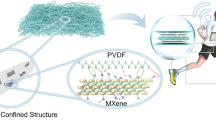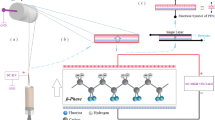Abstract
Self-sensing feature allows an actuator to be used as a sensor. Magnetoelectric (ME) composites consist of piezoelectric and magnetostrictive layers. ME composite is a proper candidate for the self-sensing feature in a wireless actuator due to its concurrent magnetic-charge order. In this study, the self-sensing feature of a nano-displacement ME actuator is investigated. The ME structure design, as well as the effect of geometric parameter and resonance frequency on the ME signal, is evaluated using a numerical modeling. The Metglas/PMN-PT/Metglas composite was fabricated as an ME actuator. The displacement measurement was conducted using a laser Doppler. The effect of bias field and excitation frequency on sensitivity, linearity, resolution and signal stability of actuator/sensor feature were evaluated by a magnetoelectric measurement setup. The experimental results revealed that the maximum sensitivity of actuator was achieved at the resonance frequency of about 60.7 kHz. Compared to the ME voltage, the phase angle was more reliable for application in the self-sensing feature. The actuator/sensor sensitivity was estimated at about 5.2 nm/mA and 0.64 mV/mA, respectively. Also, the output range of the sensoric feature was measured at 58–272 mV. The fatigue test revealed that the ME signal at the first resonance frequency was more stable than the second mode. The results also confirmed that the magnetoelectric signal could be promising candidate for the self-sensing feature in the ultrasonic nano-displacement actuator.














Similar content being viewed by others
Abbreviations
- P:
-
Piezoelectric layer
- M:
-
Magnetostrictive layer
- ME:
-
Magnetoelectric
- LDV:
-
Laser Doppler vibrometry
- FEM:
-
Finite element method
- FFT:
-
Fast Fourier transform
- RMS:
-
Root mean square
- ρ :
-
Density
- v :
-
Poisson’s ratio
- E :
-
Young modulus
- C ij :
-
Elastic stiffness constant
- σ :
-
Electrical conductivity
- M S :
-
Saturation magnetization
- χ :
-
Initial magnetic susceptibility
- \(\lambda_{\text{s}}\) :
-
Saturation magnetostriction
- \(\mu_{\text{r}}\) :
-
Relative permeability
- \(\varepsilon_{\text{r}}\) :
-
Relative permittivity
- T e :
-
Thickness
- DOF:
-
Degree of freedom
- I ac :
-
Excitation current
- d :
-
Displacement
- V :
-
Voltage
- F :
-
Working Frequency
- M B :
-
Bias field
- S A :
-
Actuator sensitivity
- S V :
-
Sensor sensitivity
- L :
-
Linearity
- N f :
-
Fatigue life
- T :
-
Working temperature
References
S. Yi, T. Li, Q. Zou, Active control of acoustics-caused nano-vibration in atomic force microscope imaging. Ultramicroscopy 195, 101–110 (2018)
J. Lin, D. Zhao, M. Lu, A. Yi, Modeling and analysis of a novel decoupled vibration-assisted swing cutting system for micro/nano-machining surface. IEEE Access 6, 70388–70396 (2018)
W.-L. Zhu, Z. Zhu, P. Guo, B.-F. Ju, A novel hybrid actuation mechanism based XY nanopositioning stage with totally decoupled kinematics. Mech. Syst. Signal Process. 99, 747–759 (2018)
J. Deng, Y. Liu, K. Li, Q. Su, H. Yu, A novel planar piezoelectric actuator with nano-positioning ability operating in bending-bending hybrid modes. Ceram. Int. 44, S164–S167 (2018)
J. Li, H. Huang, T. Morita, Stepping piezoelectric actuators with large working stroke for nano-positioning systems: a review. Sens. Actuators A 292, 39–51 (2019)
C. Clévy, M. Rakotondrabe, N. Chaillet, Signal Measurement and Estimation Techniques for Micro and Nanotechnology (Springer, New York, 2011)
M. Salim, D. Salim, D. Chandran, H.S. Aljibori, A.S. Kherbeet, Review of nano piezoelectric devices in biomedicine applications. J. Intell. Mater. Syst. Struct. 29(10), 2105–2121 (2018)
S. Valadkhan, Nano Positioning Control Using Magnetostrictive Actuators (UWSpace, Waterloo, 2007)
C.W. Nan, M.I. Bichurin, S. Dong, D. Viehland, G. Srinivasan, Multiferroic magnetoelectric composites: historical perspective, status, and future directions. J. Appl. Phys. 103(3), 031101 (2008)
D. Huang, C. Lu, H. Bing, Self-biased magnetoelectric coupling characteristics of three-phase composite transducers with nanocrystalline soft magnetic alloy. Appl. Phys. A 120(1), 115–120 (2015)
R. Gupta, M. Tomar, A. Kumar, V. Gupta, Performance of magnetoelectric PZT/Ni multiferroic system for energy harvesting application. Smart Mater. Struct. 26(3), 035002 (2017)
W. Huang et al., Ferroelectric domain switching dynamics and memristive behaviors in BiFeO3-based magnetoelectric heterojunctions. J. Phys. D 51(23), 234005 (2018)
D. Viehland, M. Wuttig, J. McCord, E. Quandt, Magnetoelectric magnetic field sensors. MRS Bull. 43(11), 834–840 (2018)
J. Ma, J. Hu, Z. Li, C.W. Nan, Recent progress in multiferroic magnetoelectric composites: from bulk to thin films. Adv. Mater. 23(9), 1062–1087 (2011)
S. Newacheck, G. Youssef, Synthesis and characterization of polarized novel 0–3 Terfenol-D/PVDF-TrFE composites. Composites B 172, 97–102 (2019)
G. Jian et al., Orientation dependence of magnetoelectric coefficient in 1-3–type BaTiO3/CoFe2O4. J. Magn. Magn. Mater. 449, 263–270 (2018)
M. Khodaei, A. Eshghinejad, S.A. SeyyedEbrahimi, S. Baik, Nanoscale magnetoelectric coupling study in (111)-oriented PZT-Co ferrite multiferroic nanobilayer thin film using piezoresponse force microscopy: effect of Co ferrite composition. Sens. Actuators A 242, 92–98 (2016)
M.P. Silva, P. Martins, A. Lasheras, J. Gutiérrez, J.M. Barandiarán, S. Lanceros-Mendez, Size effects on the magnetoelectric response on PVDF/Vitrovac 4040 laminate composites. J. Magn. Magn. Mater. 377, 29–33 (2015)
H. Palneedi et al., Highly tunable magnetoelectric response in dimensional gradient laminate composites of Fe-Ga alloy and Pb(Mg1/3Nb2/3)O3-Pb(Zr, Ti)O3 single crystal. J. Alloy. Compd. 765, 764–770 (2018)
E. Freeman et al., Improving the magnetoelectric performance of Metglas/PZT laminates by annealing in a magnetic field. Smart Mater. Struct. 26(8), 085038 (2017)
T.I. Muchenik, E.J. Barbero, Prediction of extrinsic charge, voltage, and work-conversion factors for laminated magnetoelectric composites. Smart Mater. Struct. 25(1), 015006 (2015)
L. Chen, Y. Wang, The effects of the soft magnetic alloys’ material characteristics on resonant magnetoelectric coupling for magnetostrictive/piezoelectric composites. Smart Mater. Struct. 28(4), 045003 (2019)
R. Brito-Pereira, C. Ribeiro, S. Lanceros-Mendez, P. Martins, Magnetoelectric response on Terfenol-D/P(VDF-TrFE) two-phase composites. Compos. B 120, 97–102 (2017)
F. Fang, W.Q. Jing, Magnetic field-induced ferroelectric domain structure evolution and magnetoelectric coupling for [110]-oriented PMN-PT/Terfenol-D multiferroic composites. AIP Adv. 6(1), 015008 (2016)
C. Li, X. Liu, W. Luo, D. Xu, K. He, Surfactant-assisted hydrothermal synthesis of PMN-PT nanorods. Nanoscale Res. Lett. 11(1), 49 (2016)
Z. Li, S. Zhou, G. Zhang, W. Zheng, Highly ductile and ultra-thick P-doped FeSiB amorphous alloys with excellent soft magnetic properties. Materials (Basel, Switzerland) 11(7), 1148 (2018)
J. Zhang et al., Magnetoelectric effects and power conversion efficiencies in gyrators with compositionally-graded ferrites and piezoelectrics. J. Magn. Magn. Mater. 473, 131–135 (2019)
C.-S. Park et al., Design and characterization of broadband magnetoelectric sensor. J. Appl. Phys. 105(9), 094111 (2009)
S. Hohenberger et al., Effect of double layer thickness on magnetoelectric coupling in multiferroic multilayers. J. Phys. D 51(18), 184002 (2018)
S. Li, C. Wang, Q. Shen, L. Zhang, Characterization of a BCZT/LCMO/BCZT laminated composite fabricated by plasma-activated sintering. J. Appl. Phys. 125(7), 074101 (2019)
J. Wen, J. Zhang, Y. Gao, A coupling finite element model for analysis the nonlinear dynamic magnetoelectric response of tri-layer laminate composites. Compos. Struct. 166, 163–176 (2017)
H. Talleb, Z. Ren, Finite element modeling of magnetoelectric laminate composites in considering nonlinear and load effects for energy harvesting. J. Alloys Compd. 615, 65–74 (2014)
D.A. Hadjiloizi, A.L. Kalamkarov, G.C. Saha, I. Christofi, A.V. Georgiades, Micromechanical modeling of thin composite and reinforced magnetoelectric plates—effective electrical, magnetic, thermal and product properties. Compos. B 113, 243–269 (2017)
S.Z. Mansour, R. Seethaler, Displacement and force self-sensing technique for piezoelectric actuators using a nonlinear constitutive model. IEEE Trans. Industr. Electron. (2019). https://doi.org/10.1109/tie.2018.2890486
J. Bafumba Liseli, J. Agnus, P. Lutz, M. Rakotondrabe, Optimal design of piezoelectric cantilevered actuators for charge-based self-sensing applications. Sensors 19(11), 2582 (2019)
H. Ikeda, T. Morita, High-precision positioning using a self-sensing piezoelectric actuator control with a differential detection method. Sens. Actuators A 170(1), 147–155 (2011)
K. Saigusa, T. Morita, Self-sensing control of piezoelectric positioning stage by detecting permittivity. Sens. Actuators A 226, 76–80 (2015)
T.-F. Lu, Y. Fan, T. Morita, An investigation of piezoelectric actuator high speed operation for self-sensing. Measurement 136, 105–115 (2019)
I.A. Ivan, O. Aljanaideh, J. Agnus, P. Lutz, M. Rakotondrabe, Quasi-static displacement self-sensing measurement for a 2-DOF piezoelectric cantilevered actuator. IEEE Trans. Industr. Electron. 64(8), 6330–6337 (2017)
R. Varghese et al., Magnetostriction measurement in thin films using laser Doppler vibrometry. J. Magn. Magn. Mater. 363, 179–187 (2014)
Y. Yang, B. Yang, M. Niu, Dynamic/static displacement sensor based on magnetoelectric composites. Appl. Phys. Lett. 113(3), 032903 (2018)
M. Sadeghi, Y. Hojjat, M. Khodaei, Design, analysis, and optimization of a magnetoelectric actuator using regression modeling, numerical simulation and metaheuristics algorithm. J. Mater. Sci.: Mater. Electron. 30(17), 16527–16538 (2019)
L. Chen, P. Li, Y.M. Wen, Y. Zhu, Tunable characteristics of bending resonance frequency in magnetoelectric laminated composites. Chin. Phys. B 22(7), 1–5 (2013)
S.W. Sung, J. Lee, I.B. Lee, Process Identification and PID Control (Wiley, New York, 2009)
Acknowledgements
The authors would like to thank Prof. Yumei Wen and Prof. Ping Li (Lab of sensor and Instrument system, Electronic Department, Shanghai Jiao Tong University, Shanghai, China) for their technical support in manufacturing, characterization and measurements of the magnetoelectric actuator.
Author information
Authors and Affiliations
Corresponding author
Additional information
Publisher's Note
Springer Nature remains neutral with regard to jurisdictional claims in published maps and institutional affiliations.
Electronic supplementary material
Below is the link to the electronic supplementary material.
Rights and permissions
About this article
Cite this article
Sadeghi, M., Hojjat, Y. & Khodaei, M. Self-sensing feature of the ultrasonic nano-displacement actuator in Metglas/PMN-PT/Metglas magnetoelectric composite. J Mater Sci: Mater Electron 31, 740–751 (2020). https://doi.org/10.1007/s10854-019-02581-6
Received:
Accepted:
Published:
Issue Date:
DOI: https://doi.org/10.1007/s10854-019-02581-6




